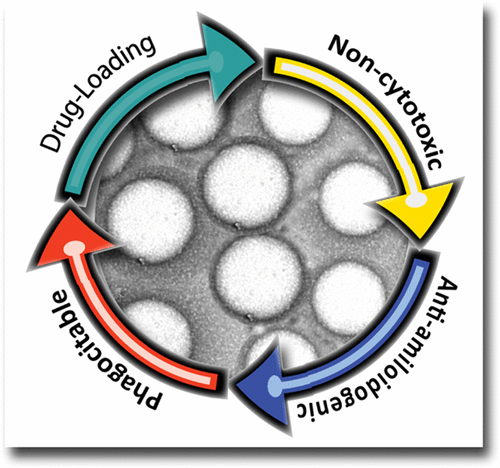当前位置:
X-MOL 学术
›
ACS Biomater. Sci. Eng.
›
论文详情
Our official English website, www.x-mol.net, welcomes your
feedback! (Note: you will need to create a separate account there.)
Green Tea Polyphenol Microparticles Based on the Oxidative Coupling of EGCG Inhibit Amyloid Aggregation/Cytotoxicity and Serve as a Platform for Drug Delivery
ACS Biomaterials Science & Engineering ( IF 5.4 ) Pub Date : 2020-06-24 , DOI: 10.1021/acsbiomaterials.0c00188 Luiza Fernandes 1 , Beatriz Messias 1 , Antonio Pereira-Neves 2 , Estefania P. Azevedo 1 , Júlia Araújo 1 , Debora Foguel 1 , Fernando L. Palhano 1
ACS Biomaterials Science & Engineering ( IF 5.4 ) Pub Date : 2020-06-24 , DOI: 10.1021/acsbiomaterials.0c00188 Luiza Fernandes 1 , Beatriz Messias 1 , Antonio Pereira-Neves 2 , Estefania P. Azevedo 1 , Júlia Araújo 1 , Debora Foguel 1 , Fernando L. Palhano 1
Affiliation

|
The accumulation of cross-β-sheet amyloid fibrils is a hallmark of all human amyloid diseases. The compound epigallocatechin-3-gallate (EGCG), the main polyphenol present in green tea, has been described to have beneficial effects in several pathologies, including amyloidogenic diseases. This polyphenol blocks amyloidogenesis and disaggregates a broad range of amyloidogenic peptides comprising amyloid fibrils in vitro. The mechanism by which EGCG acts in the context of amyloid aggregation is not clear. Most of the biological effects of EGCG are attributable to its antioxidant activity. However, EGCG-oxidized products appear to be sufficient for the majority of EGCG amyloid remodeling observed against some polypeptides. If controlled, EGCG oxidation can afford homogenous microparticles (MPs) and can serve as drug delivery agents. Herein, we produced EGCG MPs by oxidative coupling and analyzed their activity during the aggregation of the protein α-synuclein (α-syn), the main protein related to Parkinson’s disease. The MPs modestly remodeled mature amyloid fibrils and efficiently inhibited the amyloidogenic aggregation of α-syn. The MPs showed low cytotoxicity against both dopaminergic cells and microglial cells. The MPs reduced the cytotoxic effects of α-syn oligomers. Interestingly, the MPs were loaded with another antiamyloidogenic compound, increasing their activity against amyloid aggregation. We propose the use of EGCG MPs as a bifunctional strategy, blocking amyloid aggregation directly and carrying a molecule that can act synergistically to alleviate the symptoms caused by the amyloidogenic pathway.
中文翻译:

基于EGCG氧化偶联的绿茶多酚微粒可抑制淀粉样蛋白的聚集/细胞毒性,并作为药物输送的平台
跨β-折叠淀粉样蛋白原纤维的积累是所有人类淀粉样蛋白疾病的标志。化合物epigallocatechin-3-gallate(EGCG)是绿茶中存在的主要多酚,已被描述在包括淀粉样变性疾病在内的多种病理中具有有益作用。该多酚可阻止淀粉样蛋白生成,并在体外分解包括淀粉样蛋白原纤维在内的多种淀粉样蛋白生成肽。EGCG在淀粉样蛋白聚集的背景下起作用的机制尚不清楚。EGCG的大多数生物学作用都归因于其抗氧化活性。然而,针对某些多肽观察到的大多数EGCG淀粉样蛋白重塑似乎足以满足EGCG氧化产物的要求。如果得到控制,EGCG氧化可以提供均质的微粒(MPs),并且可以用作药物输送剂。本文中,我们通过氧化偶联产生了EGCG MP,并分析了与帕金森氏病相关的主要蛋白质α-突触核蛋白(α-syn)聚集期间的活性。MPs适度地重塑成熟的淀粉样蛋白原纤维,并有效抑制α-syn的淀粉样蛋白聚集。MP对多巴胺能细胞和小胶质细胞均显示出低细胞毒性。MP降低了α-syn低聚物的细胞毒性作用。有趣的是,MP载有另一种抗淀粉样蛋白的化合物,增加了其对抗淀粉样蛋白聚集的活性。我们建议将EGCG MP用作双功能策略,直接阻断淀粉样蛋白聚集并携带可以协同作用以缓解由淀粉样蛋白生成途径引起的症状的分子。
更新日期:2020-08-10
中文翻译:

基于EGCG氧化偶联的绿茶多酚微粒可抑制淀粉样蛋白的聚集/细胞毒性,并作为药物输送的平台
跨β-折叠淀粉样蛋白原纤维的积累是所有人类淀粉样蛋白疾病的标志。化合物epigallocatechin-3-gallate(EGCG)是绿茶中存在的主要多酚,已被描述在包括淀粉样变性疾病在内的多种病理中具有有益作用。该多酚可阻止淀粉样蛋白生成,并在体外分解包括淀粉样蛋白原纤维在内的多种淀粉样蛋白生成肽。EGCG在淀粉样蛋白聚集的背景下起作用的机制尚不清楚。EGCG的大多数生物学作用都归因于其抗氧化活性。然而,针对某些多肽观察到的大多数EGCG淀粉样蛋白重塑似乎足以满足EGCG氧化产物的要求。如果得到控制,EGCG氧化可以提供均质的微粒(MPs),并且可以用作药物输送剂。本文中,我们通过氧化偶联产生了EGCG MP,并分析了与帕金森氏病相关的主要蛋白质α-突触核蛋白(α-syn)聚集期间的活性。MPs适度地重塑成熟的淀粉样蛋白原纤维,并有效抑制α-syn的淀粉样蛋白聚集。MP对多巴胺能细胞和小胶质细胞均显示出低细胞毒性。MP降低了α-syn低聚物的细胞毒性作用。有趣的是,MP载有另一种抗淀粉样蛋白的化合物,增加了其对抗淀粉样蛋白聚集的活性。我们建议将EGCG MP用作双功能策略,直接阻断淀粉样蛋白聚集并携带可以协同作用以缓解由淀粉样蛋白生成途径引起的症状的分子。











































 京公网安备 11010802027423号
京公网安备 11010802027423号